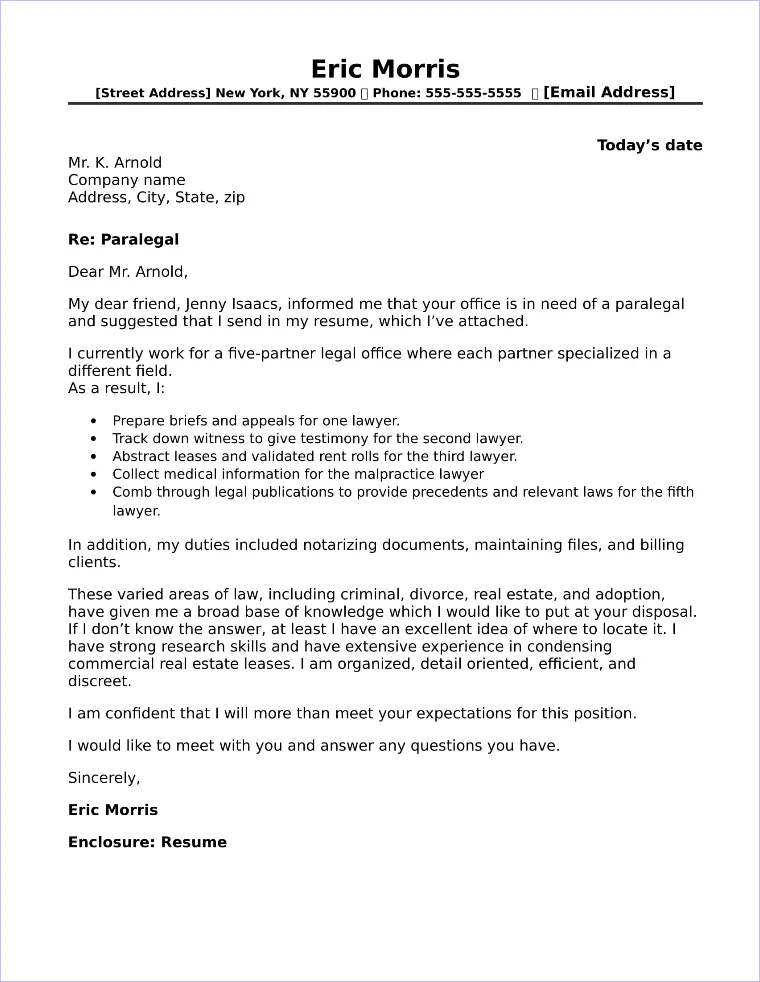What is a Paralegal Cover Letter?
A paralegal cover letter is a crucial document that accompanies your resume when applying for paralegal positions. It serves as your introduction to the hiring manager, providing a snapshot of your skills, experience, and enthusiasm for the role. Unlike a resume, which is a factual summary, a cover letter allows you to express your personality, explain your career goals, and make a compelling case for why you are the best candidate. Think of it as your personal sales pitch, designed to grab the reader’s attention and persuade them to invite you for an interview. A well-crafted cover letter can significantly increase your chances of landing your dream job in the legal field. The importance of a well-written cover letter cannot be overstated, because it’s the first impression you make on a potential employer.
Importance of a Cover Letter
The cover letter is not just a formality; it’s your opportunity to differentiate yourself from other applicants. Many hiring managers consider a cover letter essential because it reveals more about a candidate than a resume alone. It allows you to showcase your communication skills, your understanding of the job requirements, and your genuine interest in the specific position and the firm. A strong cover letter demonstrates professionalism, attention to detail, and a proactive approach. Furthermore, it allows you to address any potential weaknesses in your application, explain career transitions, or highlight unique experiences that make you a great fit. A well-written cover letter increases your chances of being noticed and sets the stage for a successful application. Employers often use cover letters to assess your writing ability, which is an essential skill for a paralegal.
Key Components of a Paralegal Cover Letter

A successful paralegal cover letter includes several key components, each playing a crucial role in making a positive impression. These components work together to create a cohesive and persuasive narrative. Proper formatting and structure is also very important. Your cover letter needs to be easy to read and navigate, with clear sections and a logical flow. These components include clear contact information, a professional header, a personalized greeting, highlighting your skills and experience, tailoring your letter to the specific job description, showcasing your achievements, quantifying accomplishments, demonstrating enthusiasm, expressing interest, and a professional closing. Each element contributes to the overall impact of your cover letter, increasing your chances of securing an interview.
Contact Information
At the top of your cover letter, include your full name, address, phone number, and professional email address. Make sure your contact information is up-to-date and easily accessible. Double-check that your email address is professional. This information allows the hiring manager to easily contact you. Clarity and accuracy here is very important. Without it, your chances of a callback are close to zero, so ensure your name, phone number, and email address are correct and easy to find.
Professional Header
Use a professional header that matches your resume. This helps maintain a consistent and polished look across your application materials. The header should include your name and contact information, formatted neatly and consistently. You can use a simple header design that includes your name and contact information, or if the job posting requests it, the company’s header. Maintaining a consistent header across all your application documents presents a professional image. This is essential, it sets the tone for the rest of your cover letter and demonstrates your attention to detail.
Addressing the Hiring Manager
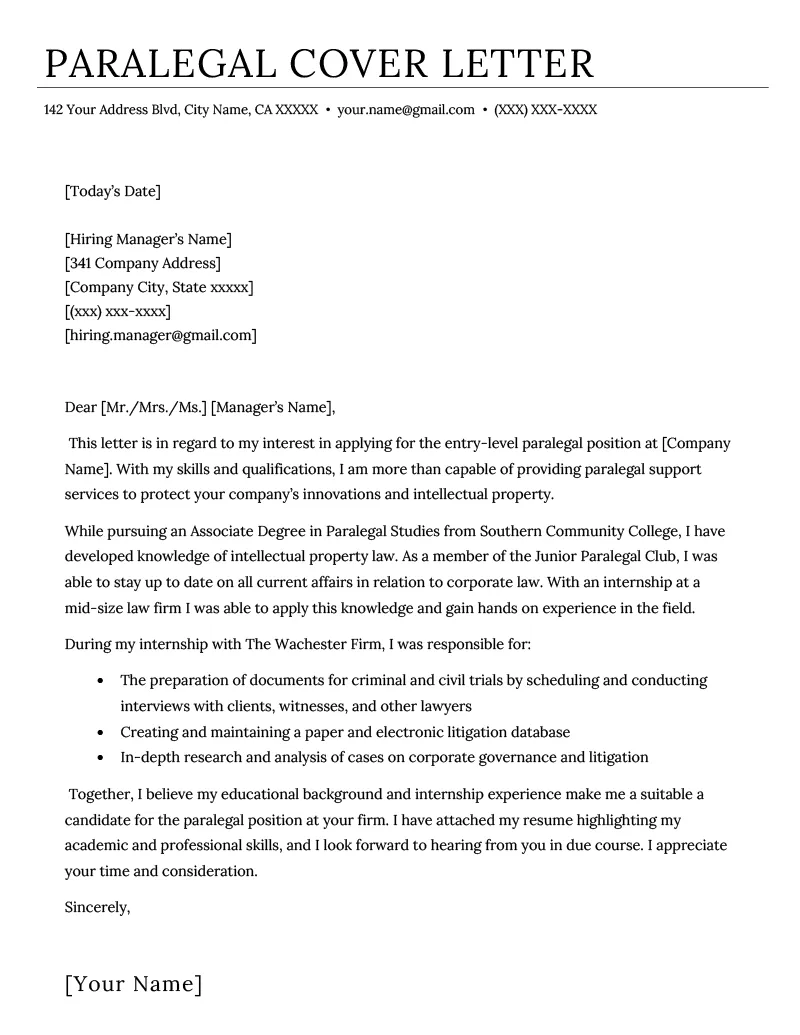
Address the hiring manager by name whenever possible. Research the company and try to find out the name of the person who will be reviewing your application. If you can’t find a specific name, use a general greeting like “Dear Hiring Manager” or “Dear [Company Name] Hiring Team.” Personalizing your greeting shows that you’ve taken the time to research the company and demonstrates your interest in the position. This small detail can make a big difference. Avoid generic greetings such as “To Whom It May Concern.” This demonstrates that you’ve put some effort in and have an appreciation of the company.
Highlighting Relevant Skills and Experience
In your cover letter, focus on the skills and experiences that are most relevant to the job description. Review the job posting carefully and identify the key qualifications the employer is seeking. Then, highlight how your skills and experiences match those requirements. Provide specific examples of how you have successfully used those skills in the past. This might include experience in legal research, drafting legal documents, managing deadlines, or communicating with clients. Always use concrete examples. Use action verbs to describe your accomplishments and emphasize your ability to perform the job. This part is crucial because it shows the hiring manager why you are a good fit for the role.
Tailoring to the Job Description
Customize your cover letter for each job application. Don’t use a generic template. Review the job description thoroughly and tailor your cover letter to match the specific requirements of the position. Use keywords from the job posting and highlight how your qualifications align with the employer’s needs. This shows the hiring manager that you have carefully read the job description and understand the requirements of the role. Customizing your cover letter demonstrates your genuine interest in the position and increases your chances of getting noticed. It is important to show the employer you understand their business and requirements.
Showcasing Achievements
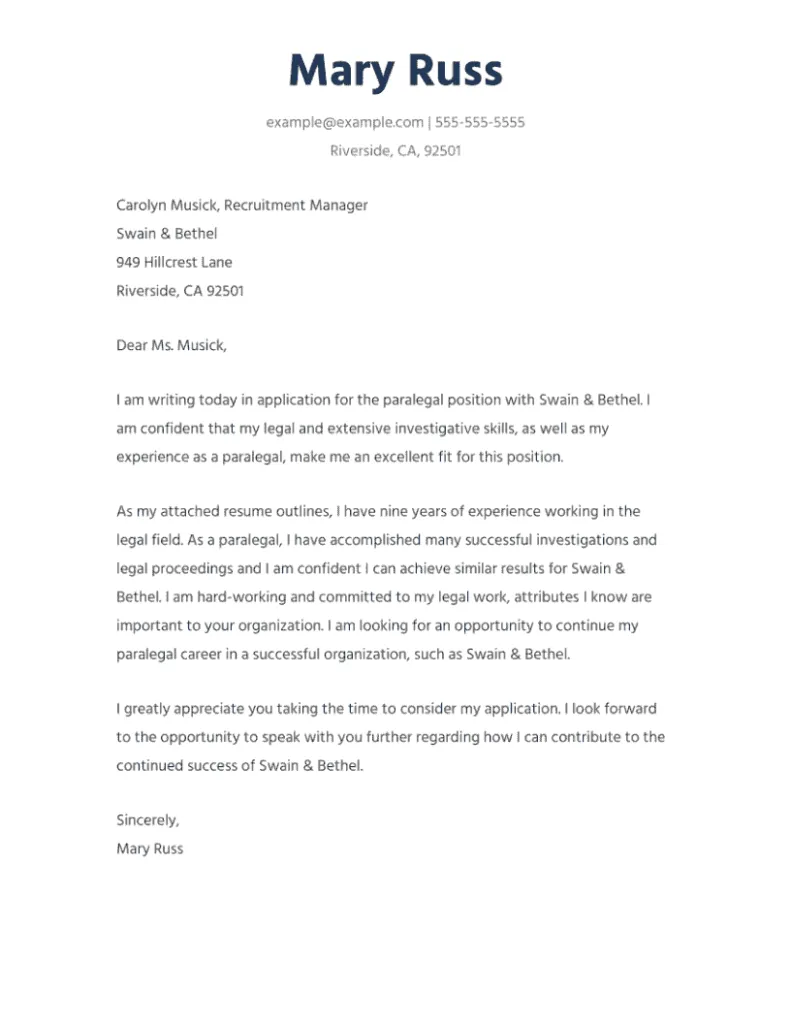
Don’t just list your responsibilities; highlight your achievements. What did you accomplish in your previous roles? How did you contribute to your team’s success? Provide specific examples of your achievements, such as successful case outcomes, improved efficiency, or positive client feedback. Quantify your accomplishments whenever possible (e.g., “Reduced case backlog by 20%”). Showcasing your achievements demonstrates your value as a paralegal and makes your application stand out. Provide examples and numbers whenever possible.
Quantifying Your Accomplishments
Whenever possible, quantify your accomplishments. Instead of saying “Improved case management,” say “Improved case management by implementing a new tracking system, resulting in a 15% reduction in processing time.” Numbers and metrics make your achievements more concrete and impactful. Quantifying your accomplishments provides concrete evidence of your skills and abilities and demonstrates the value you can bring to the employer. Use numbers to demonstrate your effectiveness. This could include the number of cases you managed, the amount of money saved, or the percentage increase in efficiency. This makes your cover letter more compelling and memorable. This adds credibility to your application.
Demonstrating Enthusiasm and Fit
Express your enthusiasm for the position and the company. Explain why you are interested in the role and how your skills and experience align with the company’s values and goals. Show that you have done your research and understand the company’s mission and culture. Demonstrating your enthusiasm makes you seem like a more engaged and committed candidate. Your interest should be genuine. This can be as simple as stating that you are excited about the opportunity. The hiring manager should get the impression that you are eager to join their team. Be as enthusiastic as possible.
Expressing Interest in the Position
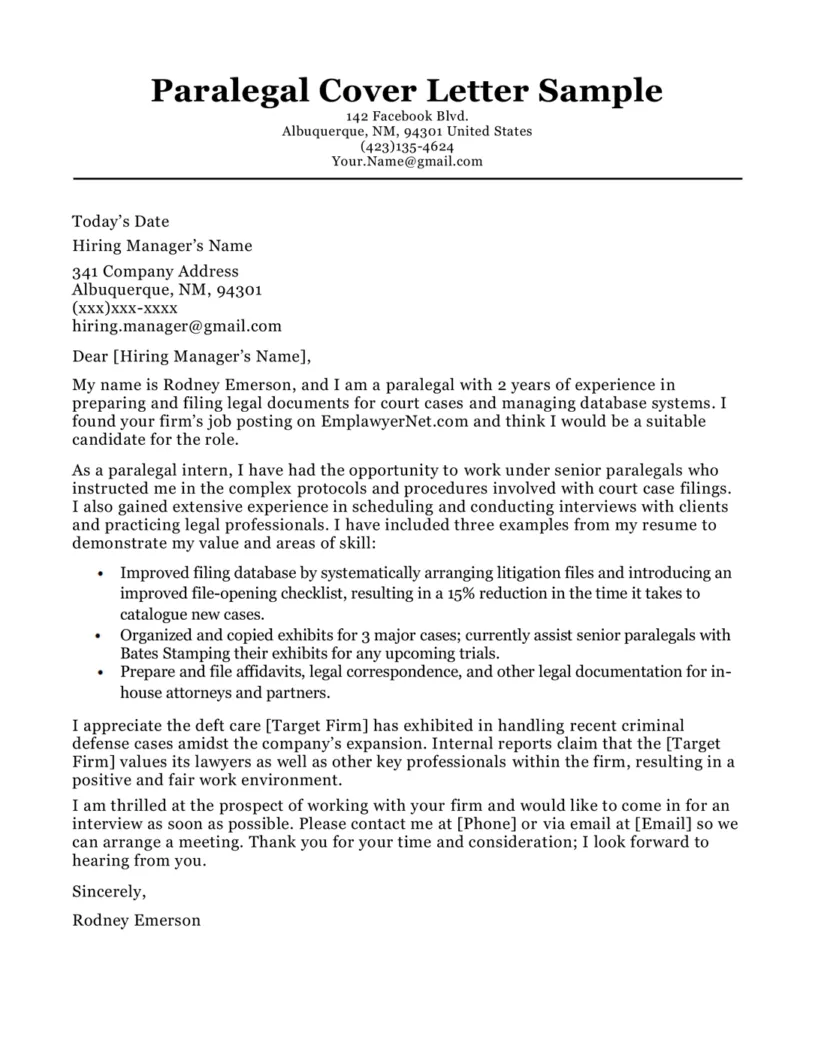
In your closing paragraph, reiterate your interest in the position and the company. Summarize your key qualifications and reiterate why you are a good fit. Make it clear that you are eager to learn more and discuss your qualifications further. End your cover letter with a strong call to action, such as requesting an interview. This shows that you are proactive and serious about the opportunity. This is your final chance to make a strong impression, show how keen you are to secure the position.
Closing the Cover Letter
Conclude your cover letter with a professional closing, such as “Sincerely,” “Best regards,” or “Respectfully.” Avoid overly casual or informal closings. Always thank the hiring manager for their time and consideration. This is an important part of your professional presentation. Choose a closing that is appropriate for the tone of your cover letter. It’s your final opportunity to present yourself in a professional manner and leave a good impression. A proper closing is very important to show how interested you are in the position.
Formal Closing and Signature
Always include a formal closing followed by your typed name. If you are submitting a physical copy of your cover letter, sign your name above your typed name. This adds a personal touch and reinforces your professionalism. If submitting electronically, simply include your typed name. This is a small detail, but it contributes to a polished and professional presentation. It should be placed just above your typed name. Ensuring the formal closing and signature is there, shows that you take the application process seriously.
Proofreading and Editing
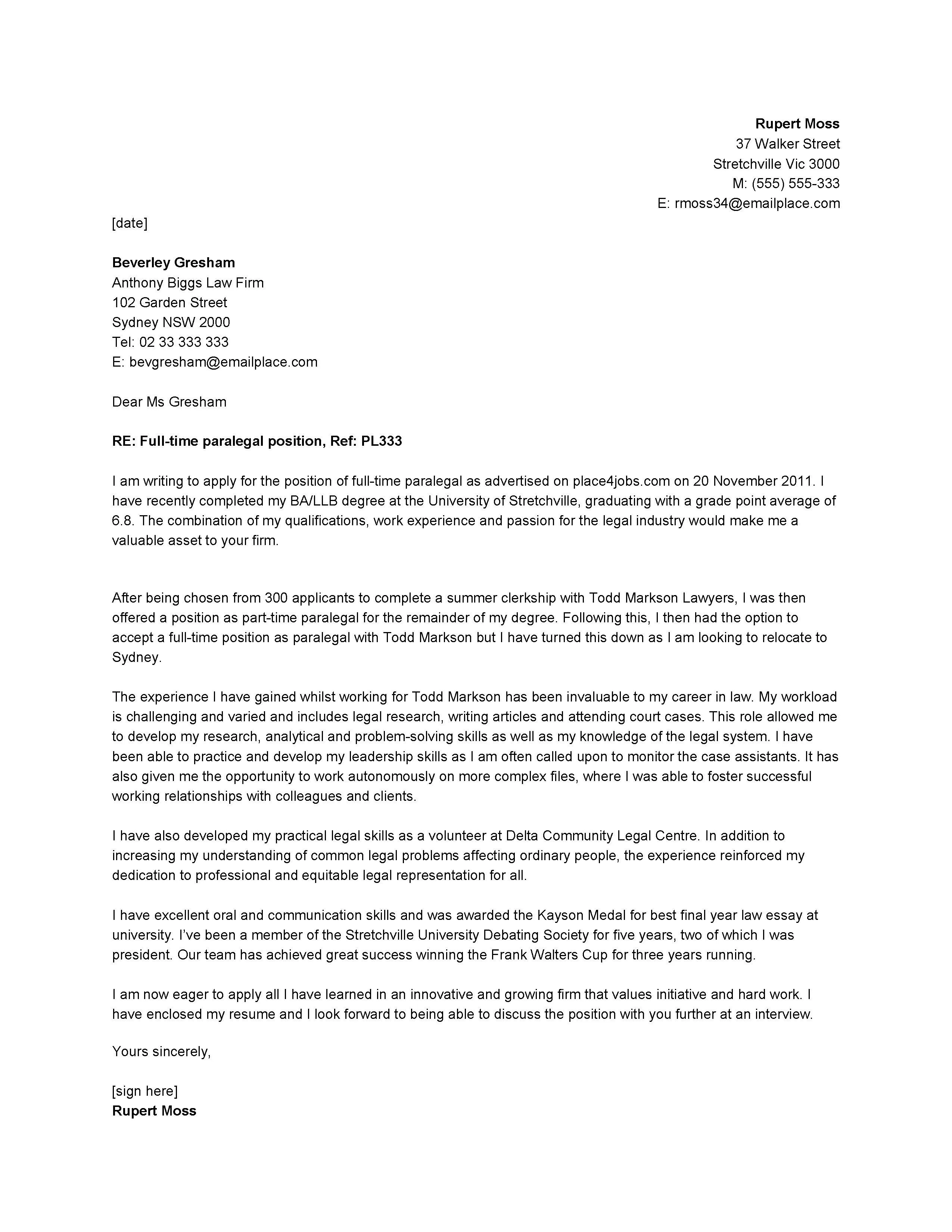
Before submitting your cover letter, proofread it carefully for any errors in grammar, spelling, punctuation, and formatting. Mistakes can undermine your credibility and make a negative impression on the hiring manager. It is important to check your cover letter multiple times. Even a minor error can detract from your overall presentation. Have a friend, family member, or career counselor review your cover letter to catch any errors you might have missed. Proofreading is essential to demonstrate your attention to detail and professionalism. Spelling and grammatical errors can make a bad impression. Ensure your cover letter is polished and error-free.
Final Review
Before sending your cover letter, take a final look to make sure everything is correct. Check your contact information, the date, the name of the hiring manager, and the company’s name. Ensure that all sections of the cover letter flow logically and that your tone is professional and enthusiastic. Make sure that your cover letter aligns with your resume and the job description. Do a final read-through to check for any missing information. A final review can make a big difference in presenting a professional application. The best way to do this is to read your cover letter out loud.
Formatting and Layout
Use a clean and professional format for your cover letter. Choose a standard font, such as Times New Roman, Arial, or Calibri, and use a font size of 11 or 12 points. Use clear headings and subheadings to organize your content and make it easy to read. Use single spacing within paragraphs and double spacing between paragraphs. Maintain consistent formatting throughout the document. A well-formatted cover letter is visually appealing and easy to read. Avoid using distracting fonts or excessive formatting. A clean layout will make your cover letter more readable and professional. Make sure the document is easy to scan.
Cover Letter Length and Structure

Keep your cover letter concise and to the point. Aim for a length of one page, unless otherwise specified in the job posting. Structure your cover letter in a logical format, with an introduction, a body, and a conclusion. The introduction should state the position you are applying for and where you saw the job posting. The body should highlight your relevant skills and experience, providing specific examples to support your claims. The conclusion should reiterate your interest in the position and your call to action. This structure ensures that you cover all the important information in a clear and organized manner. Keep your cover letter brief and focused. The hiring manager may have many cover letters to read.
Best Practices for Cover Letter
Follow these best practices to ensure that your cover letter is as effective as possible. Tailor your cover letter to each job application, highlight your relevant skills and experiences, quantify your achievements whenever possible, demonstrate your enthusiasm, and proofread carefully before submitting. Use action verbs to describe your accomplishments. Use a professional tone and a clear and concise writing style. Always customize your cover letter to suit each application. Make it specific to the job you’re applying for. By following these best practices, you can significantly increase your chances of landing an interview and securing your dream job as a paralegal. You want to present yourself as a professional who understands the job requirements.
Using Keywords
Incorporate relevant keywords from the job description throughout your cover letter. This will help your application get noticed by applicant tracking systems (ATS) and hiring managers. Identify the key skills and qualifications that the employer is seeking, and use those keywords in your cover letter. But do not overdo it. Avoid keyword stuffing, which can make your cover letter sound unnatural. The goal is to integrate keywords naturally into your writing. This will show that you understand the requirements of the job and that your skills and experience align with the employer’s needs. Identify the keywords and use them. This will make it easier for the hiring manager to find you.
Avoiding Common Mistakes
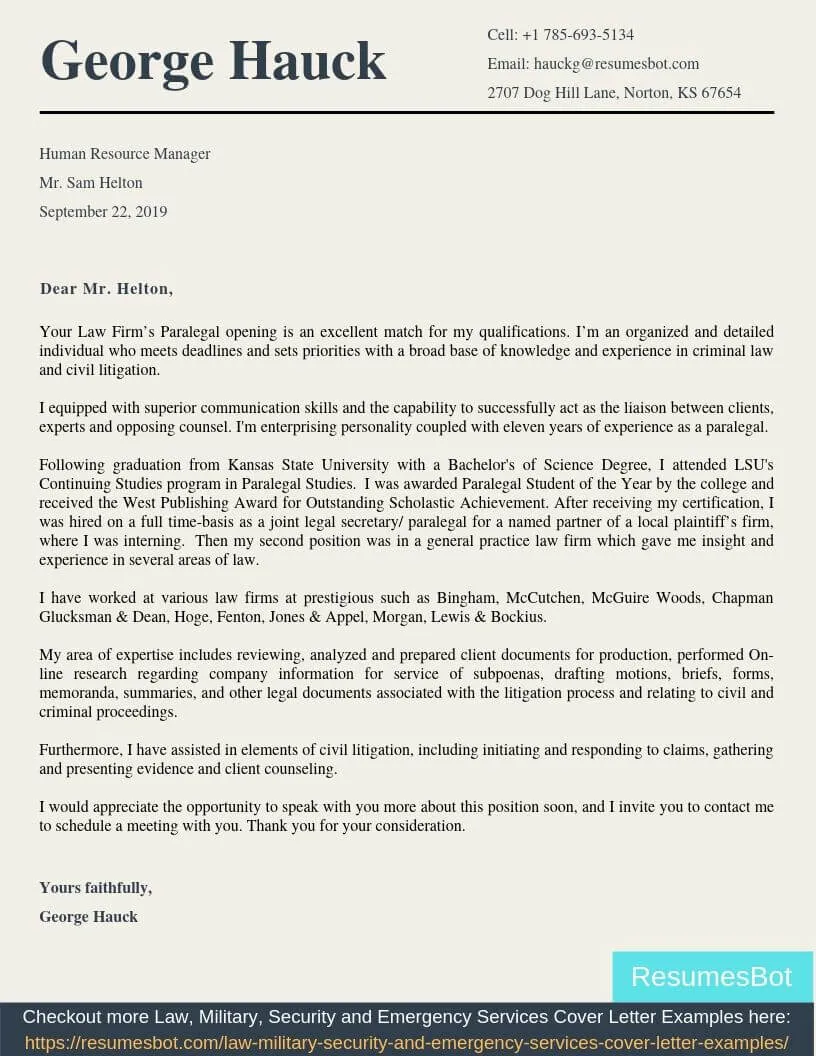
Avoid common mistakes that can damage your cover letter. These include using generic templates, not tailoring your cover letter to the job description, making grammatical errors, and focusing on what you want instead of what you can offer the employer. Do not include irrelevant information or be overly casual in your tone. Proofread your cover letter carefully to catch any errors. Avoid any negative language or criticizing previous employers. Avoiding these mistakes will help you make a strong positive impression and increase your chances of getting an interview. Focus on showcasing your value and qualifications. Always write in a positive tone.
Submitting Your Cover Letter
When submitting your cover letter, follow the instructions in the job posting. If the employer asks you to submit your cover letter as a specific file type, such as a PDF or Word document, be sure to comply with their instructions. Double-check that you have attached your cover letter and resume to your application. Also, make sure that your file names are professional and easy to understand (e.g., “Your Name_CoverLetter.pdf”). Follow the instructions in the job posting. This will show that you pay attention to detail and that you are committed to following the employer’s instructions. Ensure your cover letter and resume are easy to find.
Reviewing and Sending
Before you submit your cover letter, review it again. Make sure that all of your information is accurate and up-to-date. Check for any errors in grammar, spelling, punctuation, and formatting. Review your cover letter to ensure that it aligns with your resume and the job description. Send your cover letter. It’s time to send it! Ensure all your information is correct and professional before you send the application. By taking the time to review your cover letter, you can increase your chances of making a positive impression on the hiring manager. Reviewing your cover letter will enhance your chances of getting the job.
Following Up
After submitting your cover letter, it’s often a good idea to follow up with the hiring manager or the company. Send a brief email or make a phone call a week or two after submitting your application. This shows that you are genuinely interested in the position and that you are proactive. In your follow-up, reiterate your interest in the role and reiterate how your skills and experience align with the employer’s needs. Thank the hiring manager for their time and consideration. However, be mindful of the employer’s preferences and follow their instructions regarding follow-up. Not all employers want you to follow up. Be polite, professional, and persistent without being overbearing. Be sure to use the correct contact information. The purpose of the follow-up is to express your continued interest in the position.
